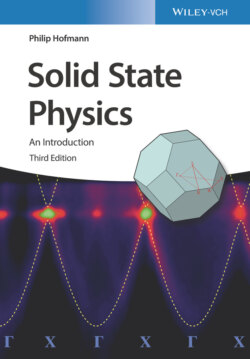Читать книгу Solid State Physics - Philip Hofmann - Страница 21
1.3.1.1 Bragg Theory
ОглавлениеBragg treated the problem as the reflection of the incident X‐rays at flat crystal planes. These planes could, for example, be the close‐packed planes making up fcc and hcp crystals, or they could be alternating Cs and Cl planes making up the CsCl structure. At first glance, the physical justification for this picture seems somewhat dubious, because the crystal planes appear certainly not “flat” for X‐rays with wavelengths on the order of atomic spacing. Nevertheless, the description proved highly successful, and we shall later see that it is actually a special case of the more complex Laue description of X‐ray diffraction.
Figure 1.8 shows the geometrical considerations behind the Bragg description. A collimated beam of monochromatic X‐rays hits the crystal. The intensity of diffracted X‐rays is measured in the specular direction. The angles of incidence and emission are 90. The condition for constructive interference is that the path length difference between the X‐rays reflected from one layer and the next layer is an integer multiple of the wavelength . In the figure, this means that , where is the distance between points A and B and is a natural number. On the other hand, we have , which leads us to the Bragg condition
(1.3)
It is obvious that if this condition is fulfilled for one specific layer and the layer below it, then it will also be fulfilled for any number of layers with identical spacing. In fact, the X‐rays penetrate very deeply into the crystal so that thousands of layers contribute to the reflection. This results in very sharp maxima in the diffracted intensity, similar to the situation for an optical grating with many lines. The Bragg condition can obviously only be fulfilled for , putting an upper limit on the wavelength of the X‐rays that can be used for crystal structure determination.
Figure 1.8 Construction for the derivation of the Bragg condition. The horizontal lines represent the crystal lattice planes that are separated by a distance . The heavy lines represent the X‐rays.
